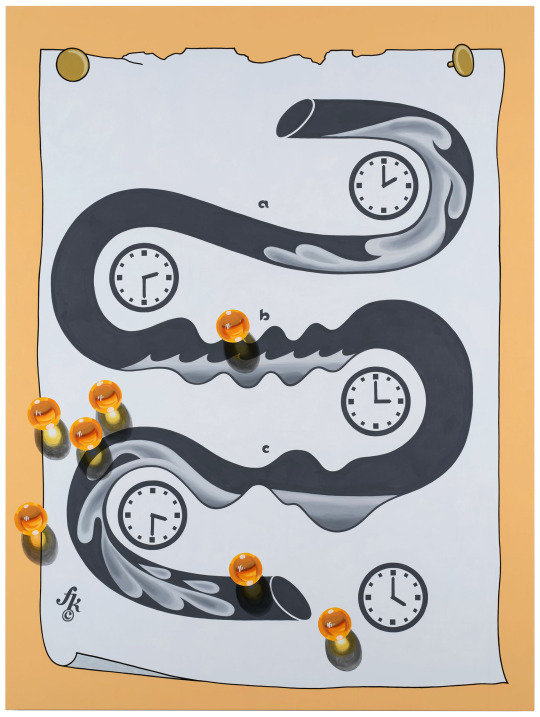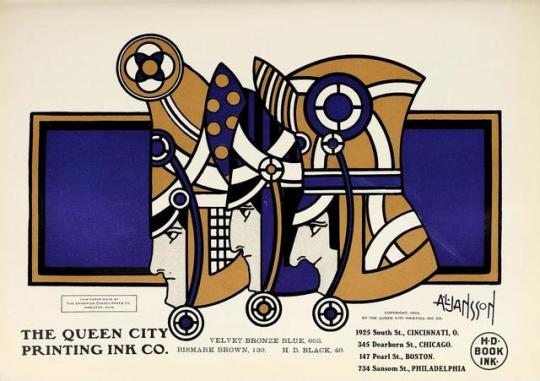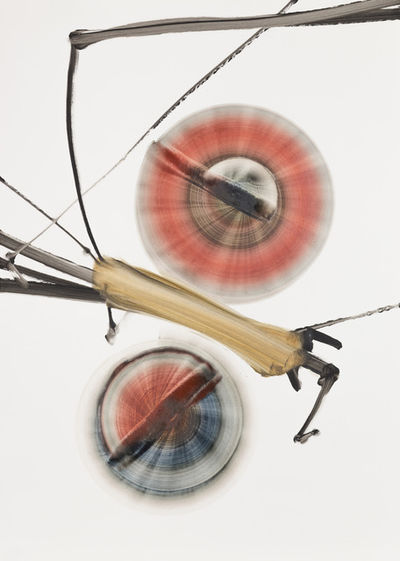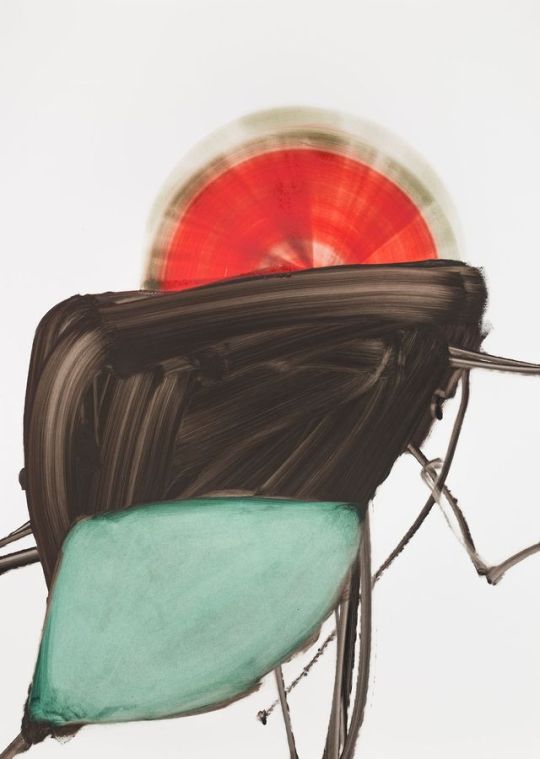Photo

Caitlin Keogh, Discipline Has Replaced Despair, 2018
29 notes
·
View notes
Photo

Domenico Veneziano, Saint Jean Baptiste dans le désert, c.1445. Tempera sur toile, 28 x 32 cm. Londres, National Gallery.
63 notes
·
View notes
Text
Peter Moosgaard - Interview about the Postdigital #vaporfolk
1. What fascinates you about the historical Cargo Cults and how has their translation to the present come about?
I am fascinated by the unsolvability, the eternal approachability of these phenomena. Since no one in the world can say what what “real faith” is. Do anthropologists learn more about their own methods of observation in this investigation of cultures? Are tourists and anthropologists deceived by the natives by getting their own pre-conception of exoticism? Has the observation of the cults contributed to the emergence of the same cults, or are the indigenous practices to be considered original? The chicken became the egg, so to speak: oppositions between observer /performer, technology /magic, facts /fiction lack a solid basis when approaching the cargo cults. They show an amazing approach towards the unknown, an “otherness”. It is neither rejected nor adopted, it is re-formulated under the circumstances of their own beliefsystem. Nothing else than what hybrid art and science is doing.
The other component is over-identification: the criticism of present ideology, techno-capitalism so to speak, has always been an integral part of the system itself. One is tempted to say the rejection of ideology today only consolidates its supremacy. Therefore, I find it exciting to take a system more seriously than it takes itself. This would mean to accept Prince Philip not as an alien king but as a local deity. To feed only from McDonalds, to bring public animal sacrifices to celebs, and always quite literally(!) do what the boss tells you to do. Overidentification is an interesting way of dealing with capitalist schizophrenia, when you can´t be serious about anything. If the art world asks for commercial products then give them “cargo” a thousand times. If an artist should always repeat the same, then make a sacred rite, a perfected loop.
2. What promises do digital technologies make today? What is our “Cargo”?
My professor said the Internet was the biggest death-suppression project in human history. So when we understand communication as an “maneuver against loneliness towards death” all posting, publishing, logging an is a bulwark against death. The men who always need a GoPro, are afraid to be forgotten. The promise of immortality by “going down in history” was virtually democratized by digital technologies, now its to “enter the cloud”. Of course, digital technologies are used for practical purposes, but you can´t explain it as a global phenomenon that way … In the networking of all communications, an old hermetic dream is reflected: The technology follows a collective longing and not primarily its everyday use. I think the cargo, that is the “divine goodies” that digital technologies promise, is the fulfillment of connectedness as an artificial concept. The promise to be able to transcend a group as rituals or political movements do. One could summarize this gnostic longing with the phrase “to be of one mind”. We want to live in an imperishable picture-world. The VR and AR is a logical consequence to this.
3. With “Digital Natives” it has been felt for some time that the enthusiasm for technology is subsiding. Especially in the metropolitan milieus one can observe a regular retreat into the analogue / manufacture. Is this a kind of counter-movement or good content for Instagram?
It is a form of counterculture, however apolitical and “idiotic” in the original sense of the word. The problem with the first screen generation is that you can avoid problems at first. You can escape pain if you only live on your iPhone. But when you identifiy with systems of such speed, one becomes nervous, frustrated, and therefore it seems now beneficial to identify with slow processes. With growth and decline of nature, manual production, crafted objects, walking etc. Which takes time. One has to realise that the speed of light is only applicable on mental processes. Here the gnositic dream, the dominance of information over matter, comes to its pre-set limits. These trends contribute to mental health, sadly they equal a balance to the “rest”, that is a techno-liberal agenda. However, this is not a public stance against the boyish innovation mythology. I would find it more exciting this counterculture to devote itself to the physical as a re-finding of the real. It is therefore a new way of thinking, that there can be no “back to nature”. Nature has never been pure, which is why you could speak of “reanimation of the real”. Matter is Mother in the end.
4. Your blog is often mentioned in connection with the “post-digital” art scene. The work that is formed by this concept is very different in form and design. What connects “postdigital” art and what attitude is expressed in it?
It’s about the radicality to see the bigger picture. After the digital has turned from a tool into a total environment, it will also be invisible (similar to a fish as the last to describe the water). There I found it exciting to create a speculative future (http://cargoclub.tumblr.com) - for example after a solar wind - in which information is erased, every electronic device remains disfunctional. Bruce Sterling also later proposed to consider this present through an Atemporality.
This postdigital speculation shows us a life in which everything material, all things mechanical remain the same, only information is gone. How would people react? Would you keep the gestures and rituals of the digital out of habit? Linking the forest, show photos to strangers in the street, adore broken devices as totems? As postdigital I would coin the “already internalized technology”. If the signs and grammar of a technology have already translated into flesh. As something which is not external to humans and therefore cannot be rejected anymore. In this case, the postdigital is a speculation, even if one were to abandon all things Hi-Tech, one would have already internalized all the games of the digital.
In general, I would say the postdigital is more of a condition than an art or some intermedia practice. Crossing the virtual to ultimately return to the material world. But everything has changed with this crossing: thinking, nature, values - reality is no longer the same. I call it Xenorealism, which is when after years on the Internet you turn the head from the screen. You recognizes the things, but nothing looks the same anymore. In my practice, this shift is expressed, because if you decide to work with tangible, primitive materials as a “digital native” To summerize, a condition of postdigital can also create new ways of accessing human rituals: cooking, walking, building, gathering, etc. These practices are not new, but are now performed for other reasons: When my grandmother used to boil juices, it was exactly what it was. When you start to make juices today, spiritual things are resonating: this is independent, artisanal, detox, local, for your soul and direct experience, etc. What was once everyday routine is discovered today as a ritual. Works from earlier times are re-emerging and perceived as semi-spiritual practices.
5. What are the prospects for these projects in regard to the relationship between man and technology?
The utopia has already been formulated, anchored firmly in the collective psyche. Humanity wants to be in augmented reality! And also meld with its components, the myth of cyborgs as “superhuman” and genetic improvement is already running. (See Critical Art Ensemble) But I am hoping that there is a counter-movement to this “propaganda of innovation” and of Eurocentric techno-solutionism. A desire for technology, which is not just self-optimization and escapism for the white man. I think there is currently a perspective on the Anthropocene emerging, an age in which humanity comprehends his role on the planet merely as a geological factor. For example, technologies that work in choreography with organic life. It could possibly be a new global imaginary (NGI),which is drastically different from today’s. For this, artists and designers are desperatly needed, art as propaganda for this new concept of globality.
Interview: Daniel Bogart, MSD Münster School of Design (DE)
22 notes
·
View notes
Text
Peter Moosgaard - Interview w/ I. Rumanova
In your work one can see everyday technological items (notebooks, headphones, cashmachines, mobile phones) turned into objects of cult - directly or made from wood, trash, vegetables. Are you using these „things“ in the same way and with the same faith Melanesians were building the bamboo radio antenas in 50s? Or is it post-everything irony?
PM: That is actually a good question. I don´t use the artistic mockups or notebooks myself, I only tend to produce them. Alltough it happened often, that i reached in my pocket and pulled out a wooden iPhone, instead of the real one. Another time two Chinese girls were really enthusiastic about my exhibition in Manila, where i made a Fake Apple Store inside of the gallery. The kids played around with the wooden iPhones and took selfies with them. But also confused them with their actual phones. That moment i thought: yes, thats the performance about Cargo. Maybe also the shipping, exchange, when someone buys a wooden phone as „ art“, but that is more of a proof of concept.
Do i really believe in the Cargo Cults? I actually don´t have to believe in something i have actual evidence for. Something that really works as a mimetic strategy. The people of Vanuathu in the beginning wanted to attract airplanes full of cargo, and soon tourists and anthropologists turned up in planes and probably brought some cash with them. The act of symbolically attracting something by imitation works - be it with words, performance, gestures or having “faith” in it. The funny thing is an anthropologist in Vienna told me i would take the Cargo Cults too serious. He said: the Cargo Cults today were mainly Fakelore, you know fake tradition. But i didn´t believe him … Who is he to say what “real faith” and what “fake faith” is? In short: it has absolutely nothing to do with irony (which is creating a distance towards the world.) There is an enormous difference between irony and overidentification. To take these things like consumerism & art etc even more seriously than they take themselves.
Is there a fetish of the handmade in the automated-to be West?
PM: You will not believe what handcrafted objects will be worth, what value will be attributed to them in future decades. I would even go as far as to say: there will be a fetish of the real itself. I am convinced that there will be a backlash to the material. There are two things involved. Apart from people being nervous and tired of constant digital streams, there will be something of a digital hangover. The simple urge to touch or craft a thing that is onesome (ger. „einfach“) in comparison to extreme digital contingency. The other reason is more theoretical. McLuhan desribed the phenomenon of a „medium becoming the content of the next medium.“ Imagine it, when Theatre became the content of Television .. it did not abolish theatre. Quite on the contrary. It made it from entertainment into an artform. In having a medium for something in the past, you can suddenly see it better than before. Maybe because you went through a process of abstraction. So how about the world and the people inhabiting it is upon the possibility of Total Simulation? You will probably start to see what was limited, what was rare, what is beyond language.
There was a strong millenarian aspect in the Cargo movements as described by anthropologists. Are we experiencing sth similar nowadays in terms of the expected ecological/economic collapse?
PM: Maybe we live in times were the threat of crisis just became a permanent condition. It never really happens, as the economy and governments make too much profit from the possibility of “impending doom 3”. Offering paternal guidance etc … but you are right, that sounds a bit conspiratorial. But if you regard it under a more philosophical viewpoint, it could actually make some sense. Nietzsche had this notion of the „Wiederkunft des Gleichen“ (eternal recurrence of the same) which asks a teleological question: Does it have to be true that everything repeats itself, or should we just live as if we had to repeat everything eternally. So the notion of an impending endpoint (judement day, nuclear war, virus, climate change) also serves a certain catalytic function in a culture.
In post-soviet countries almost every houseld possesses somewhere in the darkness of its attics, basements or garages the home-made objects and machines (be it grass-cutters, grinders, tractors, but also aesthetic objects like decorative lamps, lusters, carpets…) that were created out of lack and inaccessibility of things. Is it possible to compare this bricolage with Cargo Cult realisations?
PM: Yes, this raw look is very much the same. You work with found footage and you empower the consumer, because you work with what you have. But the intention here is different. As Cargo Objects are not functional in a classical sense. When you take the function from an object, you automatically transfer it into different domains. For example the Dadaists took away the function of everyday things, like a breakfast in fur, an iron with spikes, a telephone with a lobster etc, and therefore pointed out a poetic dimension of tools. Thats how a toilet could become an famous artwork. And if you used it, it would just be a toilet. It is similar with Cargo: By taking functionality from a thing, it reveals very different properties.
What about your fascination with brands and their hacking/faking: Is consumerism a form of worship? Is branding a form of missionarism spreading a certain vision of the world?
PM: Consumerism is definitely a substitute religion. That doesn´t mean you cant enjoy it. In the west we have this silly understanding of „pureness", that shopping is uncreative, that we should consume morally and protect our supposedly “pure soul“ from commercial influences. This conception of pureness doesn´t exist in asian cultures, as you can perfectly see at the Quing Ming in China. In spring people honor their ancestors, by ceremonially burning paper iPads, Rolex Watches, Louis Vuitton bags. At the graveyard, you will see many offerings in the form of McDonalds Fries, Coca Cola and Marlboros. The mere „product placement“ at the gravesites of Guangdong is enormous. This might point to a different conception of an afterlife. The Chinese seem to have a more pragmatic approach to the spiritual. So there is no reason, not to extend the personal preferences towards a brand to the afterlife.
Also theres a reasonable definition of magic that is, „causing change of consciousness through symbolic and narrative means”. So advertising literally makes people think about the same thing at the same time, and connects memories with a product you might buy. This altering of desires towards a brand is very close to what can be understood as magic. Logos, the way i see it, are a from of young archetype and godlike only in their power of omnipresence.
Perhaps one of the keywords of your work would be appropriation (Cargo Cults as mimetic appropriations, bricolage as functional appropriation, shanzai as brand appropriation, your own appropriations of things you find on internet). This seems to be the core of your fascination. Do you see it as a form of resistance? A Cult? Is there something that cannot be appropriated?
PM: That is a very good question, and i thought of this quite a bit. It is hard to explain what happens in the process of appropriation. What i can say is paraphrasing Byung Chul-Han is that “Only god and an idiot can live without appropriation.“ When you do appropriation in the western world it is, an act of disobedience. But that is only because western mythology is based on ideas of essentialism, which drags along so many unconsious cults of ownership, originality, authorship, categories etc. In any case appropriation is a good form of agency and of learning together. I would suggest: Just do it! :)
6 notes
·
View notes
Photo




Some of the more amazing finds in our recently digitized run of The Inland Printer are these advertisements for the Queen City Printing Ink Co. from illustrator Augustus Jansson. The ads were run from about 1903 to 1908, and are charming examples of the content found between the pages of the long-running industry magazine. We haven’t been able to find much about the illustrator, but so far, we’ve found over 30 of his colorful advertisements, including the absolutely adorable Beast Parade!



Find The Inland Printer in our Digital Library!
646 notes
·
View notes
Photo

Bak Chiang Tay (Malaysian, b. 1973) - The World Beyond 外面的世界, Pigments and acrylic on canvas, 140.0 × 140.0 cm (2016)
430 notes
·
View notes
Photo










Aulets - House in Bunyola, Mallorca 2006. Photos © José Hevia.
Keep reading
708 notes
·
View notes
Photo

Michele Mathison. Intrusion, 2017.
Pallisandro (from Nambia) marble, steel rods
85 notes
·
View notes









